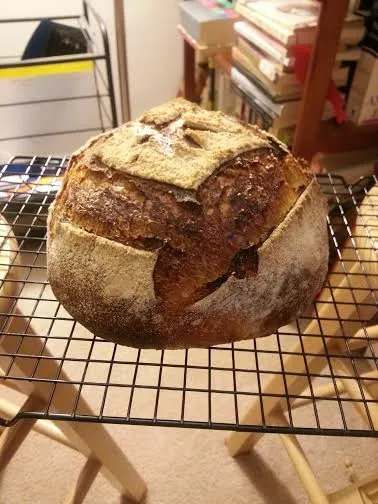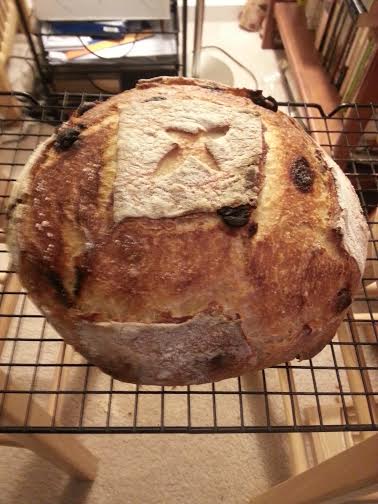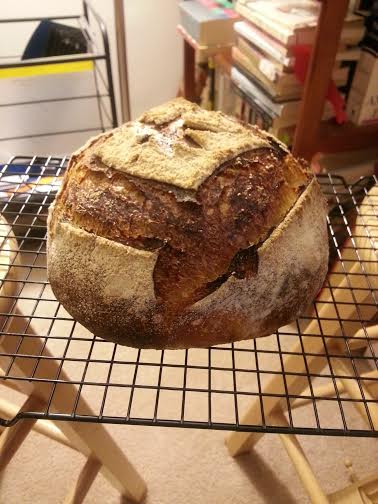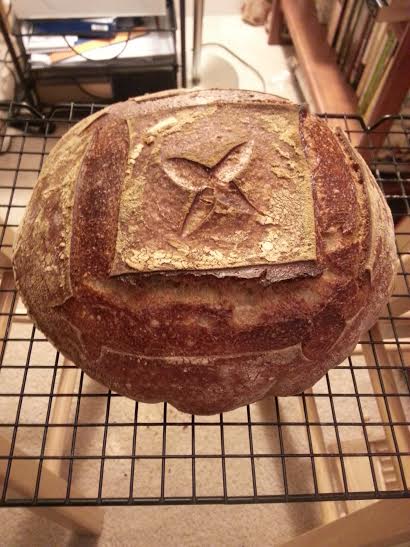
Since discovering the wonderful challenge of sourdough, I've experimented with a wide range of levain percentages, fermentation times, proof times, etc.
Most of the sources I've read have warned against too-high-hopes for sourdough ovenspring. Sometimes, a baker just wants to see that sourdough CAN really get a rise.
In my very limited experience: Preparing a dough with a significant percentage of levain + retarding during bulk fermentation + relatively short room temperature proof = great ovenspring. Oh, and not getting too wild with hydration helps too...although I'm finding that it's hard not to add more water during bulk fermentation, even if I'm going for 70-72% hydration. Wetter dough almost feels "healthier" and easier to work with, but that's probably because I've been using slaps and stretches rather than traditional kneading. The levain in this formula is about 28% of the final dough.
Whenever I have tried to use this high percentage of levain in a cold-proofed loaf, I have unwittingly over-proofed over night. Such a bummer. See, I really feel like the bulk needs to be at MINIMUM 2.5 hours, with stretches, in order to adequately develop gluten. Retarding during bulk rather than proof seems so much more forgiving, and that's why it's included in this particular formula.
The Confidence Formula:
Day 1, Morning: Create Levain
100 g 100% SD starter
100 g AP FL
100g water
Ferment for 8-12 hours
Day 1, Evening:
Mix 350g flour (whatever combination of types) with levain
Add 220-240g water
Rest (this is sort of a "faux-autolyse," emphasizing the exclusion of salt over the exclusion of leaven...)
Rest for 30 minutes
Add 11 g salt
Add 5 g malt
Stretch and fold every 30 minutes for 2 hours
Rest on the counter for 2 hours
Refrigerate for anywhere from 6 to 72 hours
Day 2
Shape and proof for 1.5 hours
Bake at 450 for 30 minutes with steam, 15-20 without.
Good Spring! Always good spring with this levain percentage, slightly lower hydration, and approach to bulk fermentation. And a more open crumb than I might have imagined for this goal!




Some bonus pics from the week: SD baked with Lagunita's Brown Shugga beer, and a browned butter SD that tasted sort of like brioche!


One thing I will say is that the crust is never as magically blistered with a shorter proof as it is with a long cold proof. But the flexibility of long cold bulk, and the spring...I'll take the trade, at least some of the time!
The grand SD experiment continues.....
--Hannah
- a_warming_trend's Blog
- Log in or register to post comments
I use a similar amount of levain however I've been using a BBA sourdough recipe that calls for 20.25oz of flour (about 575g of flour). The BBA recipe is 75% hydration however I have a loaf in the oven at this moment that is 78% hydration.
I agree with your conclusions about cold fermenting. I just got the Forkish book for Christmas and am experimenting with autolysing ... bread in the oven at the moment autolysed overnight in the refrigerator.
Cheers-
Dave
Nice looking loaf. Another example of how experimenting to find what works for you can produce great results.
When I use that much levain and a long cold proof it over proosf in the fridge too! Now i go for 11-14% levain and a 12-15 hour cold proof with a couple of hours to warm up seem give me decent spring but also great taste. In the summer I omit the bulk ferment entirely since it is so hot in my AZ kitchen. Well done and happy baking
Thanks for the great comments! dabrownman, it's nice to have some cold proofing commiseration. The 11-14% mark sounds just about perfect, based on my experience. I know some might look at my conclusion about levain percentage and say, "But doesn't all of it depend on the temperature of the water that goes into the final dough?" I agree that it's an important consideration, but I've still struggled with the cold proof when attempting 25%-30% levain.
I did have a great long-proof with 20% levain just this morning. If I can replicate it a few times, I might post that formula.
Thanks to all for your patience with my posting these amateur SD experiments!
A really smashing loaf of bread you've got there, Hannah. You certainly have a great sourdough intuition, if you're only a few months in to SD baking and are already producing loaves of such high quality. Brava
I always find that I can get great SD oven spring when I lower the hydration percentage, even if the amount of whole grain is increased substantially. Additionally, I will often go straight from cold bulk ferment to shaping and proofing, without ever letting the dough warm up, and then throwing it straight back into the fridge for a 12-20 hour proof, depending on conditions. Keeping it cold the whole time provides a nice cushion, and the yeast don't lag as much as one might expect. I think they build up their strength during the early bulk ferment, so that they'll continue to work even after being deported to the Siberian labor camp of the frigo.
Extended autolyses (8-12 hours), especially of whole grain flours, can also support oven spring, especially if you're not doing traditional kneading. The extended autolyse, I have found, greatly moves along the gluten development and provides a nice structural backbone.
Keep us posted, Hannah, and great job!
Excellent looking loaf as always Hannah,the learning never ends with bread making i am going to give this process a go and see if I succeed.
Thanks to LepainSamadie and BumbleBee84...I was actually writing a response to the former when the latter came in!
BumbleBee84, I hope it works well for you!
Lepain, your comments were so intriguing. My next frontier is heartier grains and seeds, and I won't soon forget your advice about a longer autolyse for developing gluten and increasing ovenspring.
I was especially interested in your perspective on cold temperature. I'm sort of haunted by this one sentence in Forkish's FWSY...something like, whenever natural levain is involved, "refrigerate during bulk fermentation or proofing...but not both." He didn't explain further. Why not a long cold bulk AND a long cold proof? My intuition would have suggested that the yeast wouldn't be active enough, but your comments have sparked my interest. I'm definitely going to do a dual cold fermentation/cold proof very soon.
This weekend I've been focusing on a simple formula...just testing length of bulk fermentation and levain % and their influences on the length of the final proof.
500 grams of bread flour. 200 grams of starter. Used water temperature to get dough at 80 degrees after the mixing proces was complete for a quick rise. Baked under a mixing bowl, after scoring it and spraying it with water, before putting on the baking stone.
https://www.flickr.com/photos/food_pictures/8941887392/